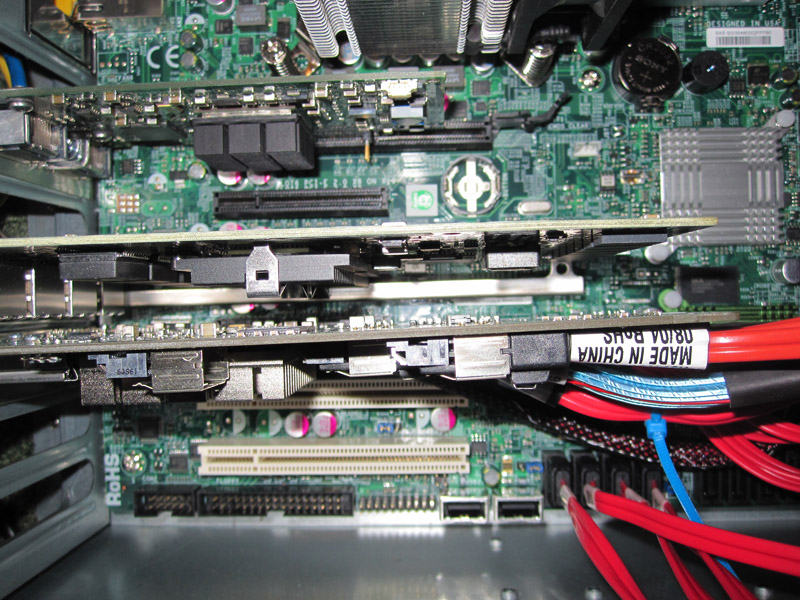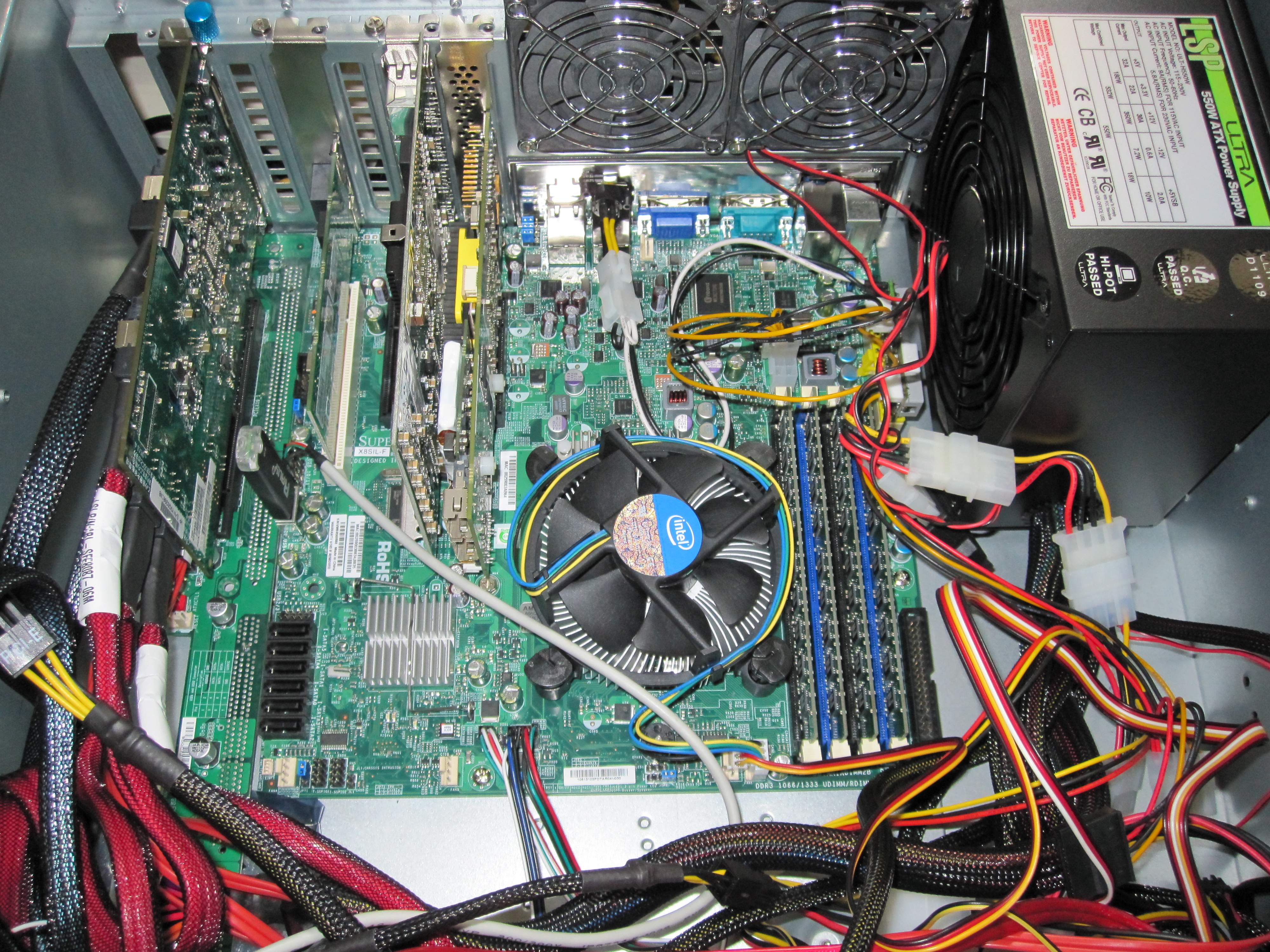First off, this is not a typical WHS build, and it was not meant to be. For the majority of users, a HP MediaSmart (by far the WHS to get if you do not DIY the build) is the way to go. For my purposes, I have seen a consistent, but increasing 500-600GB/mo of extra disk usage. Just for the record, unlike the opinion of certain Seagate executives, it is not for material of questionable moral value. Alas, I needed a solution that would allow me to have one box that could be upgraded and used for up to 24 months. As mentioned in Part 1, this project is an upgrade project and therefore I had some parts, and had a good idea of what I was doing before embarking on the project.
Hardware Specs:
CPU/ Motherboard/ Memory/ GPU/ Cooling
- Intel Core i7 920 (C1 stepping)
- Asus P6T7 WS Supercomputer
- 12GB Patriot DDR3 1600MHz
- EVGA 7200GS (Passive cooling)
Drives:
- 11x Seagate 7200.11 1.5TB
- 2x Seagate 7200.11 1TB
- 8x Western Digital Green 1.5TB
- 4x Hitachi Deskstar 2TB
- 5x Western Digital RE2 500GB Drives
Storage Controllers
- 2x Adaptec 31605
- 1x Adaptec 3085
Chassis / PSU
- Antec TruePower Quattro 1000w
- Norco RPC-4020
- Norco RPC-470
- IcyDock
- iStarUSA
At this point, there are probably some questions on the component choices. Admittedly, in a perfect world I would do a few things differently, but here is the rationale behind each piece.
CPU/ Motherboard/ Memory/ GPU
- Intel Core i7 920 (C1 stepping) – This CPU has been reliable, albeit not a great overclocker since it was purchased in November 2008. With a local Microcenter, a new D0 stepping Intel Core i7 920 was only $199, making it competitive price-wise with a LGA 1156 CPU. Also, the i7 920 allows for lots of virtual machine memory and memory bandwidth along with lots of processing power for media encoding. I almost purchased a W3520 or E5520 for this machine to get ECC memory, however, with the prospect of a hand-me down CPU and memory from my main workstation, I didn’t go that route this time. It is a gap that may be addressed in the future.
- Asus P6T7 WS Supercomputer – This was admittedly overkill. I wanted room for at least three PCIe raid controllers, and up to two dual slot video cards in the event I used the machine for Folding@Home also.
- 12GB Patriot DDR3 1600MHz – As part of the new D0 upgrade in the main system, I purchased Corsair Dominator GT memory, and therefore the new WHS got this as a hand-me-down. Again there is a known gap here regarding not having ECC memory.
- EVGA 7200GS (Passive cooling) – For now, this is the main GPU, passively cooled and has both VGA and DVI native outputs. Also, the 7200GS is a low power GPU so it does not have a huge heatsink to restrict airflow and does not require an additional PCIe power connector.
Drives:
- 11x Seagate 7200.11 1.5TB – Inherited from the old WHS
- 2x Seagate 7200.11 1TB – Inherited from the old WHS
- 8x Western Digital Green 1.5TB – Less than $95/1.5TB, low power, and I wanted to mix drive manufacturers.
- 4x Hitachi Deskstar 2TB – Fry’s had a sale for $129/ 2TB, and I wanted to backup some data before the build. Cheap capacity is always a nice thing. Also, 16 port controllers can hold a 1.5TB 9 drive raid 6 + hotspare array plus a 7 drive raid 6 + hotspare array which, to WHS, is 16TB usable. Also, I wanted to have a third drive manufacturer. Odds are another three 2TB drives will be added to this array once it goes live just to complete the array.
- 5x Western Digital RE2 500GB Drives – These drives are legacy drives used as VM sandboxes certainly will be the first to be replaced.
Storage Controllers
- 2x Adaptec 31605 – Legacy controllers. One was in the old WHS and one was in the parts bin. Both have BBUs. I standardized on Adaptec because they seem to work on anything. Also I like the Adaptec management software and did not want to run a second package. Finally, raid 1, 5, and 6 arrays can be moved from Adaptec controller to Adaptec controller. Speed was less important than getting 16 ports so the slower Intel IOP processor was not a major bottleneck (as compared to dual GigE ports)
- 1x Adaptec 3085 – Legacy controller. It has eight external ports which I wanted for the second case. Also, this of course has a BBU.
Chassis / PSU
- Antec TruePower Quattro 1000w – legacy power for the old WHS, hope that it will be sufficient for the current build.
- Norco RPC-4020 – 22 drive capacity (20 hot swap). I needed lots of drive space and this fit the bill.
- Norco RPC-470 – Legacy case as are subcomponents. 22 drives would not be enough, so this is going to be the overflow case. Building from scratch, it is more cost effective to buy a second RPC-4020.
- IcyDock
- iStarUSA
So now that the system specs are settled the next part will describe the initial build process. I will update this post with some pictures later. It is a bit challenging because half of the hardware is in production at the moment in the current WHS sitting in a closet, while the other half is on a work table. Also, upon receiving the packages of new components, I wanted to power everything on as soon as possible to make sure there were no DOA’s.




Just wanted to let you know I find this series of posts fascinating and I can’t wait to hear more. Keep up the good work.
If possible, when listing components it would be great to provide links to either the manufacturers page for the item or the newegg.com page.
I will probably do that after the build is finalized. I’m fairly sure the final drive configuration will change as I was drawing up plans to add 15k SAS drives earlier today.
The legacy hardware is still in production, and I’m starting burn-in with VMWare ESXi and Hyper-V Server to see which hypervisor I will use.
Great work keep us posted on what else you find.
This is so frustrating… I just read a post on a forum that a guy was saying… “If you buy non-RE(x), nearline, etc, enterprise drives… you will have drives drop from your array for no good reason.” So I’m sitting in my room with 8 2TB desktops and wondering how much is it worth to go enterprise… the price doubles. Have you had any problems with your hitachis?
I had a Hitachi die on me Thursday (first of about 20 installed drives now) but other than that no issues. The big thing is to test the array for a week or two before putting data on it. Raid 6 is also really good with that many drives. A lot of people have been using Hitachi’s without issues, but those are forum reports that I cannot verify.